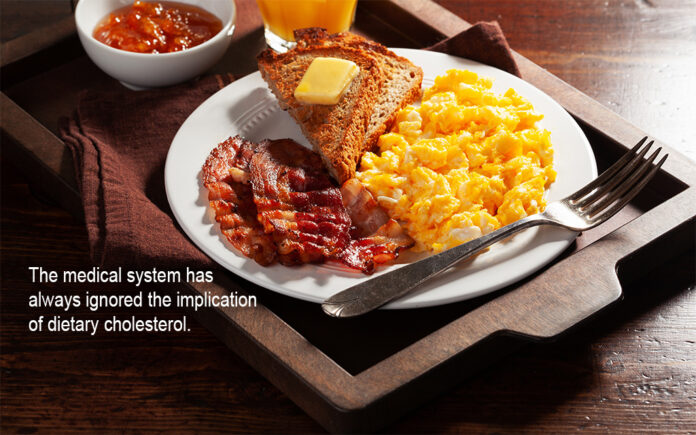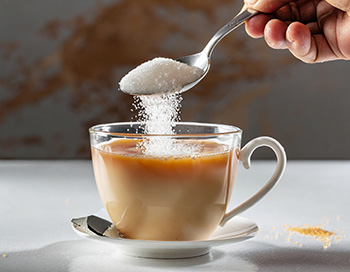Despite one hundred years of knowledge, the importance of dietary cholesterol is ignored in patient medical management to this very day. As a doctor and a patient, that omission threatened my life and limbs on several occasions, as my previous articles in Whole Food Living have covered.
We also have the continuation of the denial that dietary cholesterol has much to do with numerous chronic diseases, and cholesterol in food is kept hidden from the public. This attitude has generated some disturbing misunderstandings within the Australian community and contributes to a long list of sad facts.
Cholesterol is not an essential nutrient and does not need to be consumed. High cholesterol has no obvious symptoms, but it’s a serious, life-threatening, silent disease. High cholesterol levels are caused by two main conditions.
- Genetics: called familial hypercholesterolemia. The incidence is 1 in 300.
- Diet: dietary causes of high cholesterol affect 6.5 million adults in Australia.
This is an undeclared pandemic involving a massive 32% of the adult population. Consider the following;
- Children in their first decade of life have elevated cholesterol levels.
- An American study on road deaths revealed that 50 per cent of children under 15 showed evidence of widespread atherosclerosis.
- Anyone over 40 years has a 50 per cent chance of an elevated cholesterol level.
- Australians are issued 107 million prescriptions per year for heart and related conditions.
- Of these, 25 million are for the two leading cholesterol-lowering medications.
- This results in 40% of adults on cholesterol-lowering drugs.
- Despite this, over 42,000 Australians lose their lives annually from dietary cholesterol-related diseases.
From foods to our arteries
Elevated blood cholesterol is a warning of possible heart and stroke disease. The medication available for elevated cholesterol levels may slow and delay the disease but levels increase with every mouthful of food loaded with saturated fat and cholesterol. The medical system has always ignored the implication of dietary cholesterol and so has our government authority responsible for food labelling laws.
The Australian/New Zealand food labelling code governs what is included in food labelling. Cholesterol in food is not included on product labels, leaving the public unaware and unable to make a judgement at the point of purchase.
The US FDA (Food and Drug Administration) updated food package labels in 2016 to better inform consumers of food choices and to reflect the link between diet and chronic diseases like obesity and heart disease.
Cholesterol is in eggs, meats, poultry, fish, milk and milk-derived products and processed foods. When food containing cholesterol gets exposed to heat, during the manufacturing process and in storage, cholesterol gets oxidised. The many products that are formed are referred to as oxysterols. These accumulate in our arteries.
All types of cooking oxidise cholesterol. Chicken and fish generate oxidation more than red meats. Bakery products are also high in oxysterols when egg and dairy products are included. Ghee, (clarified butter), is particularly high in oxidised cholesterol.
Oxysterols lead to the forming of fatty deposits in arteries known as cholesterol plaques. Plaques are cheese-like deposits of cholesterol, cellular waste products, calcium, and fibrin. This will reduce essential blood flow and over a few decades, risk blocked arteries. These fatty deposits are referred to as atheroma and can commence in the first decade of life making arteries narrower, thickened, stiff and restricting the flow of blood. The most serious occurs in coronary arteries. This process is called atherosclerosis.
Within the heart, partial blockage causes angina, and complete blockage leads to heart attack. This process can occur in any organ. It is governed by your inherited genetic predisposition.
With the availability of animal and junk foods marketed relentlessly, the epidemics of obesity and other chronic diseases are hard to overcome. With 50 per cent of children having been found to have elevated cholesterol, it guarantees an increasing need for cholesterol medication, stents and coronary artery surgery.
Treatment before prevention
A common test doctors advise is to measure our cholesterol levels. This has contributed to over 40 per cent of Australian adults being on cholesterol-lowering medication. Over 107 million prescriptions for cardiovascular diseases alone were supplied to the Australian community. That is a massive 35 per cent of total pharmaceutical benefit scheme prescriptions.
Do we need dietary cholesterol?
No. The body makes all the cholesterol that’s required to maintain cell membranes and hormones and it doesn’t need to be consumed. Any amount of cholesterol can increase the formation of plaques, particularly in the coronary arteries, leading to heart attack, the one disease that causes the highest death rates.
How much cholesterol is in foods?
As indicated before, eggs, (160mg cholesterol/one 50gm egg), meats (22mg/100gm steak), poultry, (120mg/133gm chicken), fish, (71mg/100g of trout), (87mg/48g of prawns), milk and milk-derived products, (99mg/100gm cheese), and processed foods, (70mg/85g of pork sausage), is where cholesterol is consumed. These foods also contain saturated fats, known as bad fats, and little or no fibre. Most also contain higher amounts of omega-6, compared to omega-3 fats. This imbalance promotes heart disease, stroke, cancer, inflammatory and autoimmune diseases.
Overall, people on Western-style foods get 42 per cent of their dietary cholesterol from all types of meats, 25 per cent from eggs and over 30 per cent from processed foods available in the marketplace.
On the way to the greengrocers, I walked past a roadside café. Noticing a patron being served lunch, I paused to observe the meal. It was bacon and eggs with toast and butter. There were two scrambled eggs, four strips of bacon, two slices of toast and one block of foil-wrapped butter. On analysis of the nutrients, the following is noted.
Calories 650, Cholesterol 443mg, saturated fat 16gm and total fat calories for the meal are 58 per cent. That one traditional meal provides almost 25 per cent of daily calories, contains 60 per cent fat, a large helping of bad fat and nearly half a gram of oxidised cholesterol.
For interest, a 270gm serving of Coronation Quiche, (recipe published in the ABC news app), provides calories 876, cholesterol of 182mg, saturated fat of 28gm and total fat calories for each slice of 57 per cent. A generous steak (150gm) and chips with a green side salad provide 1587 calories, cholesterol of 147mg, saturated fat of 23gm and total fat calories on that plate, 57 per cent.
Cholesterol in foods is always accompanied by saturated fats. This can have a considerable effect on the LDL-cholesterol in your blood – the one that increases the risk of cardiovascular and related conditions. Even with low-fat choices, the health risks are still present, governed by the amount of food and the frequency of its consumption. High-fat foods are inviting, tempting and easily over-consumed.
Other than cholesterol and saturated fats in foods, other food ingredients and lifestyles contribute to elevated blood cholesterol. These are animal-based proteins, long-term processed sugar consumption, frequent caffeinated coffee consumption, smoking, stress, alcohol and even pregnancy. Last but not least, prescribed long-term medication such as diuretics, corticosteroids, immunosuppressants, oral oestrogen, retinoids, beta-blockers, anticonvulsants and antipsychotics can elevate cholesterol.
Four truths about cholesterol your doctor may not tell you:
- Having normal cholesterol levels doesn’t exclude heart attacks and other related diseases as I experienced.
- Thinking that cholesterol-lowering medication or coronary stents or bypass procedures will prevent heart disease is a dangerous assumption. All can have a fatality risk, and may not have any influence on the progression of heart disease.
- Being prescribed cholesterol-lowering medication and supervised by a doctor does not, and did not prevent my second, life-threatening heart attack.
- If you are on cholesterol-lowering medication but continue to eat cholesterol and saturated fat (which increases cholesterol), rich foods such as eggs, meats, fish, poultry, and numerous processed foods (baked goods, sweets, fried foods with palm and coconut oils – both high in saturated fat) with high salt, sugar, fats and trans fats. In that case, you will be continually exposed to increasing your risk of heart attack or related chronic diseases.
Following my gallbladder operation in 1982, I was advised by the surgeon and dietician to use the low-fat Heart Foundation diet, but 19 years later, I was in serious trouble.
In April 2001, I experienced mild and fleeting pains that I dismissed as inconsequential till a serious episode of chest pain on exertion. An angiogram the following morning showed a very surprising result. It showed atheromatous disease in all three coronary arteries. There were 10 sites of narrowing, from 20 per cent to 95 per cent stenosis. At a quick glance of the angiogram report, I knew it was almost impossible, to resolve that amount of disease.
With so much atheroma, the Heart Foundation dietary guidelines I had followed had failed me miserably, and I felt very uncertain of my immediate future. Before long, I experienced a classic heart attack and was rushed to theatre for emergency bypass surgery.
On returning home, I became very conscious of what food I could eat and concentrated on Heart Foundation dietary guidelines and being very diligent with my medication and exercise. I enrolled in several classes at a local gym and vowed to improve my heart health.
With a handful of medications from the cardiologist and being very conscious of the food, I struggled through a long recovery. Over the following years, the care I took, failed to prevent seriously blocking my leg arteries with cholesterol plaques, risking amputation, and then a second heart attack. Add to that, I developed early kidney failure and was bordering on osteoporosis. My future was uncertain, not knowing what other medical conditions I would be confronting until November 2018.
Enter WFPB nutrition
Within weeks of consuming whole plant foods at the exclusion of all animal-based and processed foods, my chronic diseases began to recede. Symptoms I was so familiar with faded away, and some have never returned.
The one condition I most dreaded was claudication in my lower legs, fearing amputation every time I experienced an episode. Now almost five years without any recurrence, losing part of my lower limb seems an unlikely possibility.
The nutrition I now consume is a dramatic change from what the Heart Foundation recommended. When one discovers that the evidence for heart disease prevention and reversal with diet alone was proven and published back in 1992 and again in 2005, it’s inconceivable that it is not part of routine heart disease prevention and treatment and is still ignored over thirty years later.
Popular Western food choices, including the Heart Foundation healthy low-fat guidelines, would contain the following daily amounts of nutrients: cholesterol 200 to 900mg/day, saturated fats 40 to 80g/day and total daily consumption of 30 to 50% in fat calories.
These dietary profiles have been associated with epidemics of numerous chronic diseases: obesity, high blood pressure, heart disease, cancers, Alzheimer’s disease, diabetes, stroke, kidney disease, inflammatory bowel diseases, asthma, urological, gynecological and many others.
Whole food plant-based no oil eating contains no cholesterol, is very low in saturated fat, and provides only 10 to 12 per cent of fat calories in all meals. This dietary lifestyle is the only guideline to have proven evidence to halt, slow down and even reverse chronic diseases.
Help is available
For those who want to commence a whole food plant-based dietary lifestyle, to either engage in prevention or try to slow down, halt or even reverse and disown a current chronic disease, there is help available.
Those who are at higher risk of heart disease than the general population are: current heart and stroke patients, those with a family history beyond the normal weight range, who suffer or have suffered from gallstone disease, erectile dysfunction, high cholesterol, high blood pressure, type one or two diabetes, smokers, drink excess alcohol, are sedentary or consume unhealthy nutrition.
For those with two or more of the above conditions, the risk is multiplied. By adopting healthy food choices, you will address most of the above unhealthy lifestyle consequences.
It takes only one dietary therapy to potentially slowly reduce numerous medications with their possible side effects, resolve disease burdens, improve quality of life and improve longevity. Start your plant food nutrition journey at the Australian/New Zealand non-profit website, Doctors for Nutrition, conducted by doctors, practising and prescribing whole food plant-based nutrition. Exploring this site will provide you with a wealth of evidence-based information to improve your nutrition literacy, health and wellbeing.






